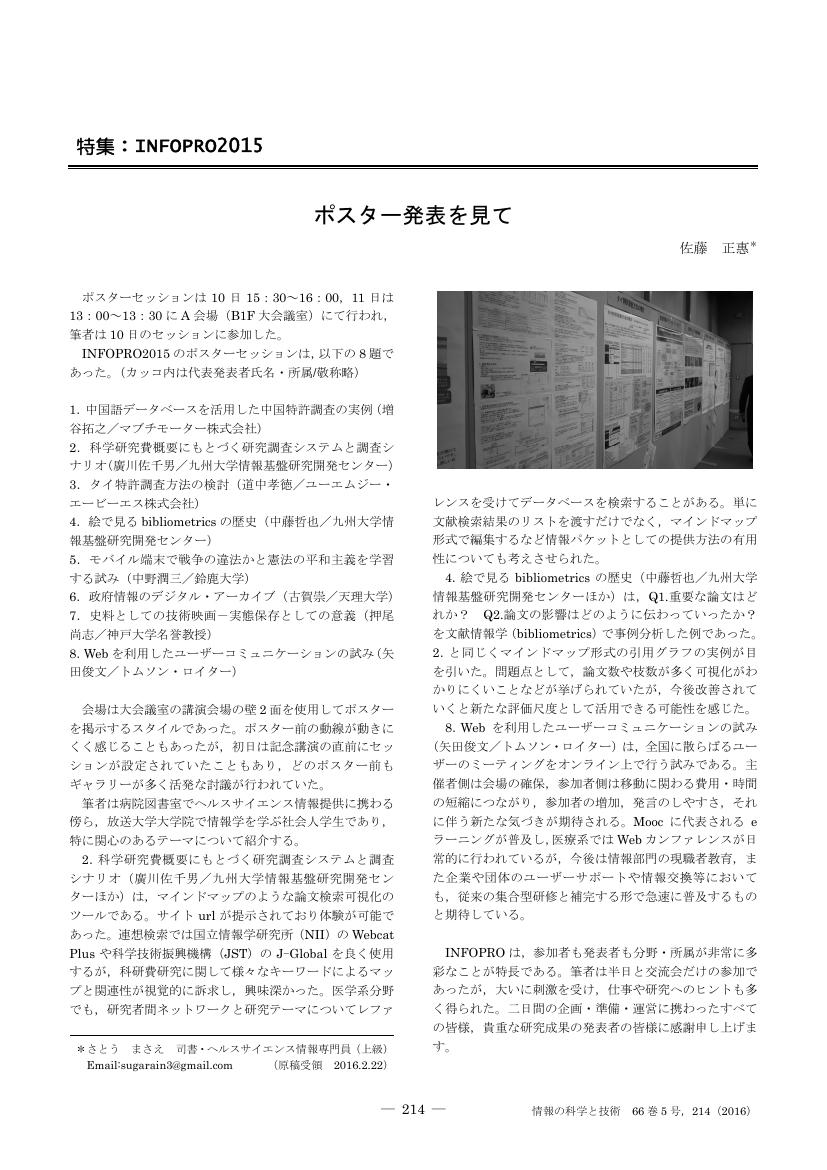7 0 0 0 OA 図書紹介 『ヘルスリテラシー:健康教育の新しいキーワード』
- 著者
- 佐藤 正惠
- 出版者
- 国立研究開発法人 科学技術振興機構
- 雑誌
- 情報管理 (ISSN:00217298)
- 巻号頁・発行日
- vol.59, no.5, pp.352-352, 2016-08-01 (Released:2016-08-01)
7 0 0 0 OA 集会報告 第33回医学情報サービス研究大会
- 著者
- 佐藤 正惠
- 出版者
- 国立研究開発法人 科学技術振興機構
- 雑誌
- 情報管理 (ISSN:00217298)
- 巻号頁・発行日
- vol.59, no.6, pp.418-420, 2016-09-01 (Released:2016-09-01)
- 参考文献数
- 4
2 0 0 0 OA 薬物療法に関する新聞記事のメディアドクター評価
- 著者
- 北澤 京子 佐藤 正惠 渡邊 清高 山本 美智子
- 出版者
- 一般社団法人 日本医薬品情報学会
- 雑誌
- 医薬品情報学 (ISSN:13451464)
- 巻号頁・発行日
- vol.21, no.3, pp.109-115, 2019-11-30 (Released:2019-12-25)
- 参考文献数
- 12
- 被引用文献数
- 2
Objective: The objective of this study was to examine information quality by quantitatively evaluating newspaper stories on drug therapy using the “Media Doctor” instrument.Methods: A database search was conducted to extract newspaper stories on drug therapy published between July 1, 2017 and December 31, 2017. Two evaluators independently evaluated each story using the “Media Doctor” instrument. Each of the 10 evaluation criteria were rated as “satisfactory” or “not satisfactory.” When the content of the story was not suitable for the evaluation criteria, it was regarded as “not applicable”.Results: Fifty-nine news stories (Asahi: 13, Mainichi: 8, Nikkei: 8, Sankei: 14, Yomiuri: 16) were included. The median number of evaluation criteria that the two evaluators judged as “satisfactory” was 5. The proportions of stories that the two evaluators judged as satisfactory were “1. availability,” 73%; “2. novelty,” 66%; “3. alternatives,” 39%; “4. disease mongering,” 58%; “5. evidence,” 32%; “6. quantification of benefits,” 31%; “7. harm,” 41%; “8. cost,” 22%; “9. sources of information/conflict of interest,” 12%; and “10. headline,” 66%. Conversely, the proportions of stories judged as “not satisfactory” were “1. availability,” 0%; “2. novelty,” 5%; “3. alternatives,” 12%; “4. disease mongering,” 8%; “5. evidence,” 24%; “6. quantification of benefits,” 29%; “7. harm,” 41%; “8. cost,”44%; “9. sources of information/conflict of interest,” 32%; and “10. headline,” 12%.Conclusion: These results suggest that the quality of newspaper stories are insufficient as drug information in terms of the validity of its scientific evidence.
- 著者
- 佐藤 正惠
- 出版者
- 一般社団法人 情報科学技術協会
- 雑誌
- 情報の科学と技術 (ISSN:09133801)
- 巻号頁・発行日
- vol.72, no.4, pp.128-132, 2022-04-01 (Released:2022-04-01)
2020年3月にパンデミックが宣言されたCOVID-19感染症は,2022年1月現在もウイルス変異により猛威を振るい続けており,社会生活は大きく変貌した。医療体制,ワクチン接種等をめぐり,根拠の不確かなニュースが氾濫するインフォデミックが危惧される状況となっている。本稿は,主に公共図書館における情報の吟味と提供を考える。疑問の定型化,エビデンス・ピラミッドや6Sピラミッドと情報検索,フェイクニュースへの海外の対応について述べる。さらに医療・健康に関する報道について質の向上を目指すメディアドクター研究会の活動を紹介し,メディアリテラシーについての話題を提供する。
2 0 0 0 OA ポスター発表を見て
- 著者
- 佐藤 正惠
- 出版者
- 一般社団法人 情報科学技術協会
- 雑誌
- 情報の科学と技術 (ISSN:09133801)
- 巻号頁・発行日
- vol.66, no.5, pp.214-214, 2016-05-01 (Released:2016-05-01)
2 0 0 0 OA 第31回医学情報サービス研究大会(MIS31)
- 著者
- 佐藤 正惠
- 出版者
- 国立研究開発法人 科学技術振興機構
- 雑誌
- 情報管理 (ISSN:00217298)
- 巻号頁・発行日
- vol.57, no.7, pp.501-503, 2014-10-01 (Released:2014-10-01)
- 参考文献数
- 4
- 著者
- 佐藤 正惠
- 出版者
- 一般社団法人 情報科学技術協会
- 雑誌
- 情報の科学と技術 (ISSN:09133801)
- 巻号頁・発行日
- vol.71, no.12, pp.537-539, 2021-12-01 (Released:2021-12-01)
2020年からのCOVID-19流行により,学会・研究会や会議はZoom等のWeb配信またはハイブリッド形式が主流になった。筆者は東京のJSTとWeb配信のハイブリッドで開催されたINFOPRO2021に参加し,2021年7月2日に口頭発表を行った。プレゼンテーション・ツールとして初めてMorressier(モレシエ)を使用したので,その体験を述べる。Morressierは会場参加に即したイメージで作られており,発表者は事前に登録したMorreierのシステム上で,直前までUpdateが可能である。また,研究者情報のORCIDのIDと連動しているのも研究者にとって利便性が高い。課題として,運営側で使用するにはまだ日本語でのサポートが十分でないため,事前のレクチャーや説明を十分に行う必要がある。
- 著者
- 三輪眞 木子 佐藤 正惠 山下 ユミ 磯部 ゆき江 阿部 由美子
- 出版者
- 一般社団法人 情報科学技術協会
- 雑誌
- 情報プロフェッショナルシンポジウム予稿集 第18回情報プロフェッショナルシンポジウム
- 巻号頁・発行日
- pp.67-72, 2021 (Released:2021-06-21)
高齢者のヘルスリテラシーと健康寿命の関係を探求するため、医療者計10名を対象に、2020年1月~6月に、対面、Web、電話により半構造化インタビューを実施した。健康維持に前向きな高齢者は家族との関係が良く、健康への関心が高く、食事や規則正しい生活に気を付け、趣味等の楽しみや目標を持ち、話し好きで仲間がいる。ヘルスコミュニケーションがとれている高齢者は治療がうまくいっており家族のサポートがあり、テレビや新聞等で健康医療知識を得ている。治療に関する意思決定に積極的に参加する高齢者は、主体的に健康医療情報を獲得する。高齢者には、かかりつけ医を作る、運動する、家族と親密につきあう、自分の健康に関心を持つ、趣味や目標を持つ、栄養バランスの良い食生活を心掛ける、外に関心を持ち仲間とともに取り組むことが求められる。健康維持への取組に男女差があり、仕事を辞めた後、地域と関連しない孤立男性に課題があることが示唆された。
- 著者
- 佐藤 正惠 北澤 京子 渡邊 清高
- 出版者
- 一般社団法人 情報科学技術協会
- 雑誌
- 情報プロフェッショナルシンポジウム予稿集 第18回情報プロフェッショナルシンポジウム
- 巻号頁・発行日
- pp.61-66, 2021 (Released:2021-06-21)
COVID-19流行により、信頼性に乏しい医療・健康情報インフォデミックへの関心が高まっている。メディアドクターは医療に関するメディア報道のあり方を検討する活動である。豪で始まり、日本では2007年にメディアドクター研究会が発足した。定例会での多職種によるディスカッションを通じて、メディア&ヘルスリテラシー向上につながっている。COVID-19の影響で2020年はオンラインのみで開催した。その成果と課題を報告する。
1 0 0 0 OA 病院患者図書室とエンベディッド・ライブラリアン:
- 著者
- 佐藤 正惠
- 出版者
- 一般社団法人 情報科学技術協会
- 雑誌
- 情報プロフェッショナルシンポジウム予稿集 第12回情報プロフェッショナルシンポジウム
- 巻号頁・発行日
- pp.35-39, 2015 (Released:2015-12-04)
- 参考文献数
- 12
日本は世界に類を見ない高齢化社会を迎えようとしており、厚生労働省は日本の医療機関に対し、ベビーブーマー世代が後期高齢者を迎える「2025年問題」に向けたロードマップで、各機関の役割明確化と在宅医療を推進している。 病院内の図書室は、医療法第22条により地域医療支援病院に設置が定められた共同利用施設であり、院内および地域の医療従事者に学術支援を行う役割がある。 また病院内に患者のための図書室(以下、患者図書室)を設置する動きが増加しているが、これは「がん対策基本法」により、がん診療連携拠点病院や自治体には患者への医療情報提供が義務付けられたことや、「健康増進法」制定、患者サービスの一環等の理由による。 病院図書室には、医療における1990年代からの根拠に基づく医療(EBM:Evidence based Medicine)推進の流れを受け、医療従事者や患者への科学的根拠のある情報提供が求められてきたが、一般市民にとっても、健康情報リテラシーの向上は喫緊の課題である。 図書館員の役割として、利用者に積極的に溶け込んで情報サービスを行う「エンベディッド・ライブラリアン」が注目されている。 本稿では、患者図書室の状況や役割を概観し、さらに自治体や公共図書館との連携・患者会や地域などへエンベディッドして活動する図書館員の役割と課題を考察する。
- 著者
- 渡邊 清高 佐藤 正惠
- 出版者
- 国立研究開発法人 科学技術振興機構
- 雑誌
- 情報管理 (ISSN:00217298)
- 巻号頁・発行日
- vol.60, no.4, pp.284-285, 2017-07-01 (Released:2017-07-01)
- 著者
- 佐藤 正惠
- 出版者
- 日本薬学図書館協議会
- 雑誌
- 薬学図書館 = Pharmaceutical library bulletin (ISSN:03862062)
- 巻号頁・発行日
- vol.61, no.4, pp.208-215, 2016
1 0 0 0 集会報告 第33回医学情報サービス研究大会
- 著者
- 佐藤 正惠
- 出版者
- 国立研究開発法人 科学技術振興機構
- 雑誌
- 情報管理 (ISSN:00217298)
- 巻号頁・発行日
- vol.59, no.6, pp.418-420, 2016



